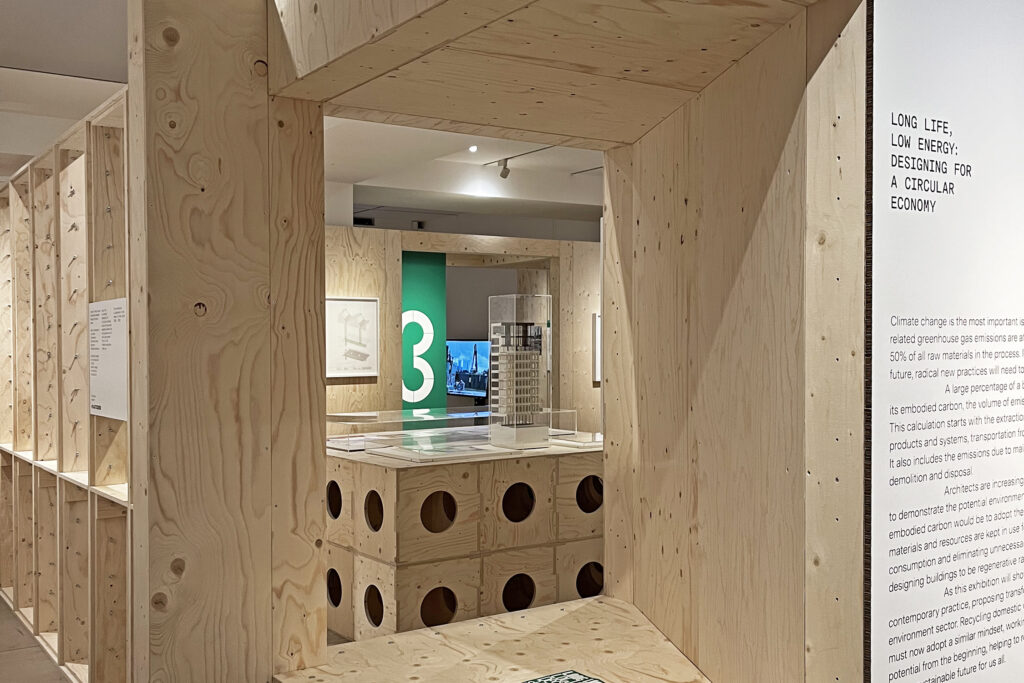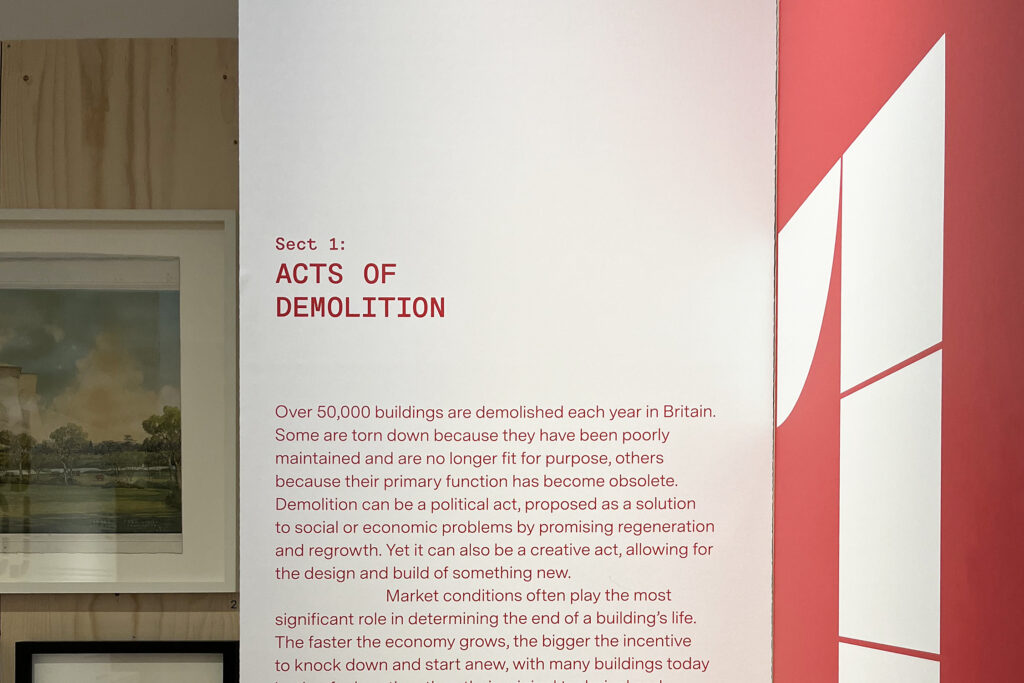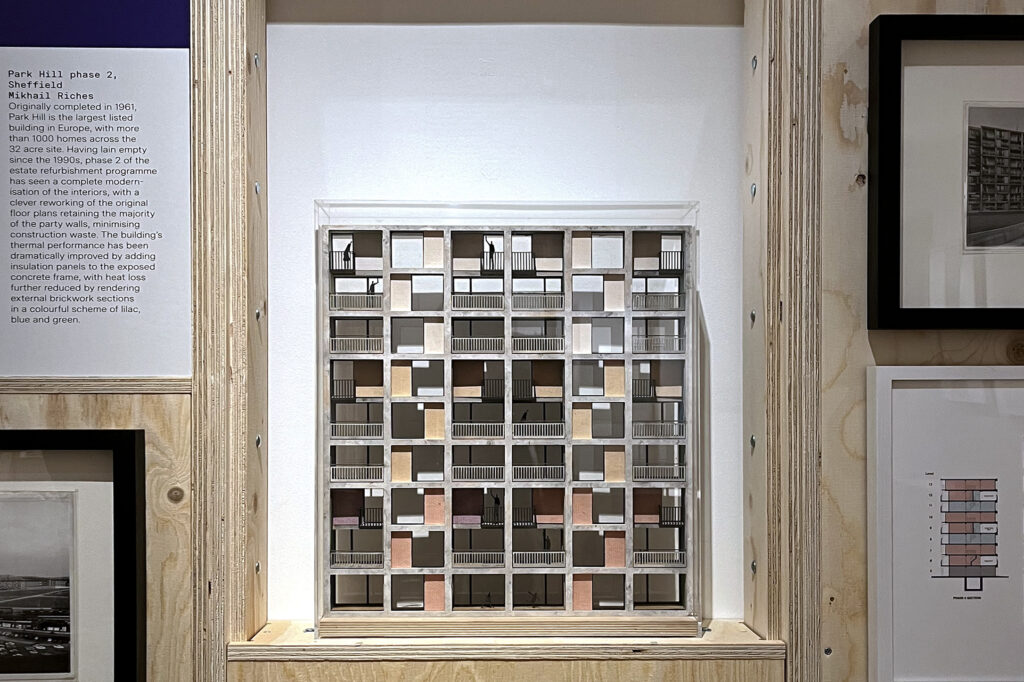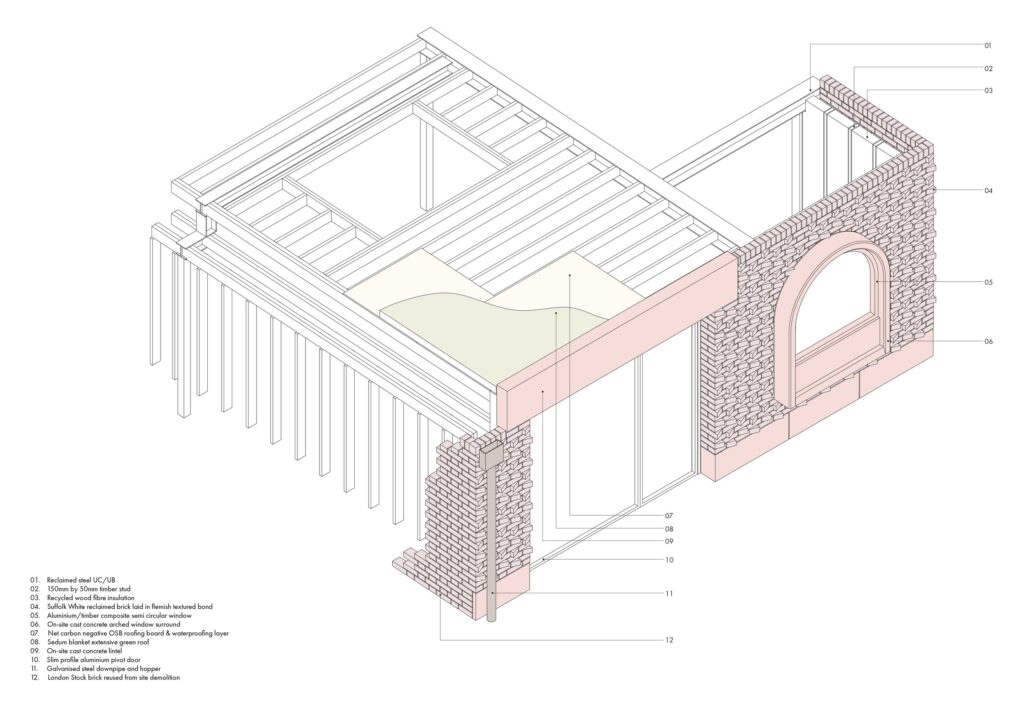Exhibition interview with Curator at Royal Institute of British Architects, Pete Collard – February 2023 at RIBA, Portland House, London.

Interviewer: The first thing I noticed about this exhibition was that it feels quite analogue – although its construction was digitally driven, the display methods don’t rely on digital technology. Was this always the intention?
Pete Collard: I think that we use the word analogue which is, fundamentally, what this show is. In my practice as a curator, I’m always keen to vary the media that we present, because architecture will only ever be representational in a gallery; it will only ever be a drawing, a model, a film and so on. We hope the exhibition is varied and intuitive. At RIBA, we have the RIBA collections to work with, which is the starting point of every exhibition in a way; it’s a brilliant resource.
Circular economy, as a subject matter, is not well-represented in the collections; we’re going back hundreds and hundreds of years. But I want the exhibition to be as much about looking backwards as it is about looking forwards, which can only really be an analogue process in terms of the materials at our disposal.
Having collated all of these materials, we’ve been trying to put on a varied, engaging, busy show whilst simultaneously using the past as a reference point. So the actual presentation is very digital and precise; from the beginning, we wanted to find a way that allowed these works to sit within a system that demonstrated everything that we’re trying to say about this exhibition.
That’s why U-Build was an obvious choice because there’s very little wastage. It’s all modular and it fits together. All the perspex is reused, all the frames are reused. Apart from the electricity being used to power the film and the lights, we’ve been as sustainable as we can be, but that’s where technology is central to this. U-Build is working on methods of waste reduction, which then becomes representative of everything we’re trying to show in here as well. For example, the next exhibition will reuse this structure in a different way. You won’t see any plywood, so that’s the main challenge. We’re going to be a bit more creative in terms of the overall look and feel.

I: You haven’t been afraid to show quite niche pieces, for example, you have a perforated panel next to a large sheet of glass and some timber behind you, along with photographs of works in progress and the sites. It feels like it would have been easy to represent each one of these projects in a more standardised way, with drawings and photos of the finished products, but it feels more varied and rich this way.
PC: Yes, we approached each one on a case-by-case basis. For this section, Retrofit, it was a case of trying to be representative geographically, making sure we weren’t too London-focused. The idea, for instance, is that when the show goes to Liverpool, we’ll swap out some of the London projects you see here. We then have to look at each project and ask what the key thing is about that project – what’s the important thing that we want to say and what’s the best way of saying it in terms of available materials?
In the case of Battersea Power Station, we had these beautiful drawings – actually, one of the joys of my job is being able to go through portfolios such as these. Architecture is about the evolution of practice. We can make a comparison: this is how you worked in the 1930s and this is how we are working in the 21st century.
With Park Hill, one of the key areas was the reconfiguration of the floor plans. They wanted to minimise their waste in terms of knocking walls down, reducing operational carbon, making changes to the facade and so on, and we needed a model that would speak to the work that they put into doing that.
At RIBA, we are curious about the evolution of architectural practice in the era of climate change, and how these practices rise to meet this challenge, especially in terms of curation. How do you draw a reuse project? How do you acknowledge the old building within your scheme whilst adding your own language?

I: How do you think you can show that dialogue? How can you get it across through visual communication?
PC: Tŷ Pawb by Featherstone Young is a great example of this. They have a unique style, and they’ve used some Photoshop to get the artwork in, but it’s about acknowledging that this is an old car park that they’ve cut in various areas to get light wells. The way that they draw and layer and add that little speckling of concrete – you understand it and you understand the vision.
The joy of my job is that I get to converse with these architects and understand how they communicate. And that’s what we are doing here, we are communicating architecture, primarily to the public, but also to architects themselves.
I: How did you decide to pitch the show? Is it possible to appeal to people walking in off the street and experienced architects at the same time?
PC: If you’re not working in architecture or even in some areas of industry, you might not understand what the circular economy is. This is a members’ gallery; it’s for RIBA members to present their work to other members, but also to the public. So we tried to appeal to both of these audiences by breaking the show up a little bit.
For instance, one section is a little bit more public-oriented – we included Battersea because it’s quite recognisable. But we also wanted to demonstrate the range and breadth of some of our projects.
The next section is a little bit more forward-thinking, and non-specialists may find it harder to absorb all of the ideas and understand their significance. The steel reuse film, for example, concerns a new initiative to reuse steel frames rather than smelting them, which is not really happening in practice. However, it could happen more, and so we try to appeal to audiences, raise awareness of these issues and increase the likelihood of them happening.
Material passports are a classic example; if more developers were involved in schemes like this, there would be a much bigger database of second-hand materials and more people could re-specify second-hand parts, which is what we’ve got on show here. They’re not glamorous or high-end, but they’re incredibly important, and RIBA feels that more people should be on board.
So the average person who just walked in off the street might not quite grasp the importance of these kinds of projects – we’ve got some very unsexy things on display, but they’re architecturally very significant.
But we’ve attracted a real mix of people. I’ve done more tours for this show than I’ve done for any other show, since we’ve had a lot of interest from organisations such as the British Council and English Heritage. The groups I’ve been most inspired by are student groups; the young people are so switched on, and this is the kind of thing they want to be doing. It’s been hugely encouraging because it gives them a chance to see different methods of communication.

I: You draw on a lot of archive materials from the collections. Above that layer of content is the graphic approach and identity with things like interpretation panels and strong colour coding, which adds a sense of clarity and zoning. Did you approach StudioBuild for their ability to bring this?
PC: We approached them because we think they’re very good. With graphic design, you’re asking somebody to understand a concept or a theme, and translate it into a language that will effectively communicate what you’re trying to say – and they did it brilliantly. The work they’ve done for us is modern and fresh, and it helps frame each section with colour. People understand where they are and that there’s a sort of slight transition in the narrative as they’re walking round.
I am mindful that some exhibitions look and feel the same the entire way round. We wanted this exhibition to encourage exploration – putting the steel reuse film in is quite interesting as it’s a change of pace from models, as well as a chance to sit down! There’s a point to be made by confronting people with the reality of materials.
The approach for each section was also slightly different. So for Section Two, because the works are completed, we felt there should be some acknowledgement of them being completed; however, where we’ve displayed works in progress and uncompleted projects, we wanted it to feel a bit looser and informal; a bit like a student presentation. We just used these little magnets. It’s a bit “messier”, because if you start framing things that are not finished, it can dilute or change the nature of finished projects.
I think I should also say that the response to the show has been very positive in that all of the practices and manufacturers went one step further to be a part of it and support it, which is wonderful.
I: How many practices were involved in the show?
PC: About 15 practices, which is great. And what we’re also trying to do, is not just focus on the larger practices, but some of the smaller ones as well. There’s a real range.

I: You had the RIBA Youth Forum involved in the assembly of the show – was that fun?
PC: Yeah, that was great! The Youth Forum is a really important part of RIBA because it’s offering an outlet to kids who want to be involved in architecture – there’s no architectural curriculum subjects for them at that age. And we wanted to give them something to do! And they loved it. We’ll likely use them again in the future because it gives them confidence, it gives them an understanding of a build, and it looks good on their CV.
I: You mentioned that the exhibition makes good use of print and other physical mediums. Did you have opportunities to add more digital elements, such as 3D models or AR and VR, from some of the practices involved?
PC: Yes, because practices always have digital models that you can bring in, but budget is always an issue, and I think if you’re going to do things like that, you need to do them well. Most of the drawings you see here were probably articulated on a screen, and have lived their entire lives on a screen. So how do we, as an organisation, articulate how an architect works today? How many folders are there of materials and different iterations? At what point do you collect drawings or digital files? And how do you communicate that? Because if you show the drawing on a screen and it’s static, it’s like the screen becomes a kind of ubiquitous porthole into how we consume culture.
I hope that analogue and traditional mediums are more engaging because they involve things that you don’t see in everyday life. I think we could have been a bit more current in certain sections, but these things take time and cost money to develop. But I would love to find that balance; once you’re led by technology, you’re just doing it for the sake of having technology. The worst thing as a curator is a screen that’s out of order!
I: What feedback will you take forward from this exhibition to apply to future shows?
PC: The level of work being done by architects of their own volition – in particular, there’s a proportion of architects who are in their mid-30s and doing jobs that didn’t exist five years ago – is hugely positive as it shows that a lot of practices are transforming from the inside. Every mid-sized practice has somebody now who looks at driving forward research, the best ways of working and so on. The level of interest in the subject has also been hugely positive; I think it suggests a desire to change how we design and build, which can only be positive.
As a curator, I’m very pleased with the response to the show’s format and structure; it may not always be the case, but there’s usually a place for an old-fashioned show. There’s so much to be learned from form-making, sketching and so on. That’s what I wanted this show to do; to acknowledge practice.
Interview and photographs: B. Couture & T. Ahmed. Edited by Daisy Couture
Further details
Exhibition dates and locations:
RIBA London, 08 November 2022 – 01 March 2023
Tate Liverpool, 27 October 2023 – 14 January 2024